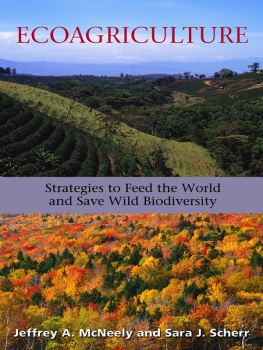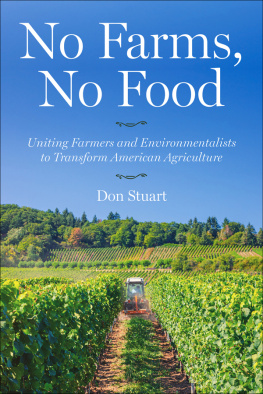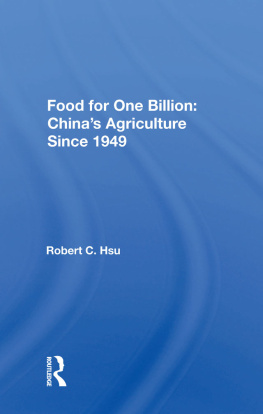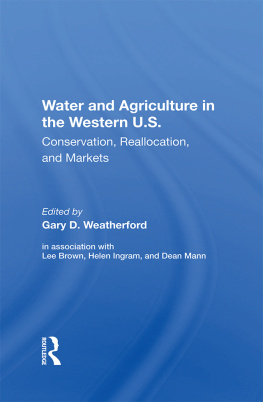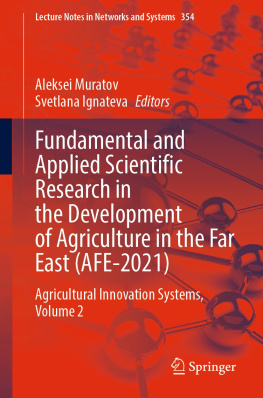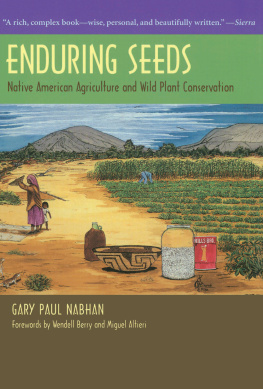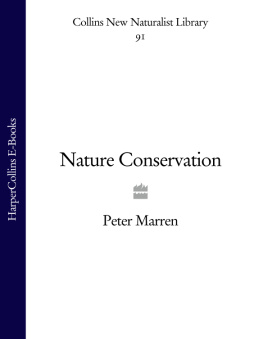Farming and the
Fate of Wild Nature
Essays in Conservation-Based Agriculture
Edited by
Daniel Imhoff and Jo Ann Baumgartner

Healdsburg, California
2006, Watershed Media/Wild Farm Alliance. All rights reserved under International and Pan-American Copyrights Conventions. No part of this book may be reproduced in any form or by any means without permission in writing from the publisher.
Published by Watershed Media
513 Brown Street
Healdsburg, California 95448
www.watershedmedia.org
Produced by the Wild Farm Alliance
P.O. Box 2570
Watsonville, California 95077
www.wildfarmalliance.org
Distributed by
University of California Press
Berkeley and Los Angeles, California
University of California Press, Ltd.
London, England
www.ucpress.edu
Cover Photo Credits
Farm scene: Raymond Gehman,
National Geographic Image Collection
Bobcat: Susan Morse
Pacific treefrog: Kelly McAllister,
Washington Department of
Fish and Wildlife
Red-tailed bumblebee: David Cappaet,
www.forestryimages.org
Barred owl: John Triana, Regional Water
Authority, www.forestryimages.org
Library of Congress Cataloging-in-Publication Data available upon request from the publisher.
on acid-free, 100 percent post-consumer recycled, processed chlorine-free paper.
ISBN:978-0-9846-3042-4
First Edition
08 07 06 05
10 9 8 7 6 5 4 3 2 1
The following essays were previously published either in their entirety or in a longer form and have been reprinted with permission from their authors/publishers. All other essays appear for the first time in this volume. All rights are retained by their authors/publishers.
Wendell Berry, Conservationist and Agrarian, in Citizenship Papers, Shoemaker & Hoard, 2004.
Richard Manning, The Oil We Eat: Following the Food Chain Back to Iraq, Harpers Magazine, February 2004.
Barbara Kingsolver, A Forests Last Stand, in Small Wonder: Essays. HarperCollins, 2002.
Ted Williams, Salmon Stakes. Audubon, March 2003.
Gary Paul Nabhan and Ana Valenzuela-Zapata, When the Epidemic Hit the King of Clones, in Tequila: A Natural and Cultural History, The University of Arizona Press, 2004.
Scott McMillon, Wild Work Crew: Rocky Creek Landowner Puts Resident Beavers to Work, Bozeman Daily Chronicle, June 16, 2002.
Luba Vangelova, Living with Wolves, Wildlife Conservation Magazine, March/April 2003.
Daniel Imhoff, A Plea for Bees, Vegetarian Times, June 2005.
Aldo Leopold, A Biotic View of Land, in The River of the Mother of God and Other Essays, The University of Wisconsin Press, 1991.
Dave Foreman, adapted from a forthcoming book, The Myth(s) of the Environmental Movement: Why Nature Lovers Must Take Back the Conservation Movement.
Reed Noss, Context Matters: Considerations for Large-Scale Conservation, Conservation in Practice, Summer 2002.
Rick Bass, Keeping Track, Forest Magazine, September/October 2000.
John Terborgh, James Estes, Paul Paquet, Katherine Ralls, Diane Boyd-Heger, Brian Miller, and Reed Noss, The Role of Top Carnivores in Regulating Terrestrial Ecosystems, in Continental Conservation. Island Press, 1991.
Michael Pollan, The Way We Live Now: the (Agri)Cultural Contradictions of Obesity, New York Times Magazine, October 12, 2003.
Brian Halweil, Can Organic Farming Feed Us All? WorldWatch, May/June 2006.
Dan Barber, Food Without Fear, New York Times, November 23, 2004.
Gretel H. Schueller, David Seideman, Jennifer Bogo, and Angie Jabine. Taste for Conservation, Audubon, May 2004.
CONTENTS
Gary Paul Nabhan & Ana Guadalupe Valenzuela-Zapata
John Terborgh, James Estes, Paul Paquet, Katherine Ralls, Diane Boyd-Heger, Brian Miller, and Reed Noss
Dan Barber
Jennifer Bogo, Angie Jabine, Gretel Schueller, David Seideman
For years, Farming and the Fate of Wild Nature remained one of those elusive projects that seemed so obvious and necessary yet so difficult to christen with a final production deadline. But in the publishing world, nothing really seems to count unless its finishedwhatever that truly meansand in early 2006 the Wild Farm Alliance and Watershed Media made this reader a collaborative priority. It is with both excitement and gratitude to so many individuals and organizations that we send this book out to the reading public. Our sincere thanks go to our graphic design team: Timothy Rice for the layout of the book and Kevin Cross for its cover. We were fortunate once again to have Janet Reed Blake as our editor. Christen and Ryan Crumley provided outstanding editorial assistance, and Ellen Sherron produced our index.
This book could not have been possible without the express support from the Foundation for Sustainability and Innovation, Gaia Fund, Garfield Foundation, Patagonia Inc., True North Foundation, and Wallace Genetic Foundation who have so generously stood behind the mission of the Wild Farm Alliance. The great board members of the Wild Farm Alliance, who have remained energized and united since the organizations beginnings in January 2000, need to be heartily acknowledged, and we hope that this volume brings a sense of pride to their ongoing commitment. Thanks also go to Watershed Medias distribution partner, the University of California Press, in particular Hannah Love.
We further wish to thank Merrilee Buchanan, Sam Earnshaw, Quincey Tompkins Imhoff, and Jack Shoemaker for their support behind the scenes; and the board of directors of Watershed MediaRoberto Carra, Jib Ellison, John Harvey, Greg Hendrickson, Diana Donlon Karlenzig, and Anne Telford.
Most of all, we need to thank the many authors, illustrators, and photographers involved, so many of whom donated their work and their skills to give this book its shape and scope. We are truly humbled and grateful and hopeful for a future alive with wildness and the agrarian spirit.
Daniel Imhoff and Jo Ann Baumgartner, August 2006
A good farm must be one where the native flora and fauna have lost acreage without losing their existence.
Aldo Leopold
W e have collected, mulled over, and carefully considered the following essays over a three-year period and chosen them to provide the scientific, philosophical, economic, and cultural underpinnings for an emerging movement, conservation-based agriculture. A number of the essays also influenced a previous book, Farming with the Wild, a project that inspired a continental journey in pursuit of two questions. How much wildnesss can a farm or ranching operation support and still remain economically viable? And how much agriculture can take place in an area and still support optimal levels of biodiversity? The Wild Farm Alliance, the co-producer of this and the earlier book, has been engaged in these questions for nearly a decade and continues to be a leading voice for the re-integration of wildness in farming and ranching regions.
Our world is rapidly changing, and the actions we take today will have far-flung consequences. Many alarming trends cumulatively point to inevitable shifts in agriculture in the years ahead: Changing climate patterns. Limited cheap fossil fuels. Rapid urbanization and rising rates of industrial consumption. Approaching shortages of clean water. The collapse of critical ecosystems overburdened by industrial wastes. The irreparable loss of species, and with them, the planets evolutionary legacy as well as the genetic resilience to overcome pest outbreaks and other hardships. The pages ahead will reveal a broad platform of conservation-based solutions to many of these challenges.


